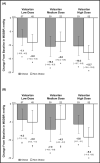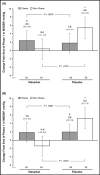The efficacy and safety of valsartan in obese and non-obese pediatric hypertensive patients
- PMID: 21974764
- PMCID: PMC8108891
- DOI: 10.1111/j.1751-7176.2011.00502.x
The efficacy and safety of valsartan in obese and non-obese pediatric hypertensive patients
Abstract
This post hoc analysis assessed the efficacy and tolerability of valsartan for the treatment of hypertension in obese vs non-obese children and adolescents. After a 1-week antihypertensive washout period, 142 obese and 119 non-obese hypertensive children and adolescents aged 6 to 16 years were randomized to 2 weeks of once-daily treatment with valsartan 10 to 20 mg, 40 to 80 mg, or 80 to 160 mg, followed by re-randomization to either valsartan or placebo for an additional 2 weeks. Patients could continue to receive valsartan during an optional 52-week, open-label extension. Valsartan resulted in statistically significant (P<.05) and clinically relevant reductions in mean sitting blood pressure (BP), ranging from approximately 7/4 mm Hg (valsartan 10-20 mg) to 13/9 mm Hg (valsartan 80-160 mg) in both obese and non-obese patients. BP control was achieved in 44% of obese and 56% of non-obese patients. Following re-randomization, non-obese patients experienced an increase in BP during placebo treatment, albeit levels remained below baseline, whereas BP reductions were maintained in valsartan recipients (P<.05). The most frequent adverse events during the open-label phase were headache and fever. Valsartan provides similar antihypertensive efficacy in obese and non-obese hypertensive children and adolescents, with good tolerability in both patient populations.
© 2011 Wiley Periodicals, Inc.
Figures



Similar articles
-
Efficacy and tolerability of combination therapy with valsartan plus hydrochlorothiazide compared with amlodipine monotherapy in hypertensive patients with other cardiovascular risk factors: the VAST study.Clin Ther. 2005 May;27(5):578-87. doi: 10.1016/j.clinthera.2005.05.006. Clin Ther. 2005. PMID: 15978306 Clinical Trial.
-
Tolerability and blood pressure-lowering efficacy of the combination of amlodipine plus valsartan compared with lisinopril plus hydrochlorothiazide in adult patients with stage 2 hypertension.Clin Ther. 2007 Feb;29(2):279-89. doi: 10.1016/j.clinthera.2007.02.003. Clin Ther. 2007. PMID: 17472820 Clinical Trial.
-
Comparison of valsartan 160 mg with lisinopril 20 mg, given as monotherapy or in combination with a diuretic, for the treatment of hypertension: the Blood Pressure Reduction and Tolerability of Valsartan in Comparison with Lisinopril (PREVAIL) study.Clin Ther. 2004 Jun;26(6):855-65. doi: 10.1016/s0149-2918(04)90129-4. Clin Ther. 2004. PMID: 15262456 Clinical Trial.
-
Amlodipine/valsartan single-pill combination: a review of its use in the management of hypertension.Am J Cardiovasc Drugs. 2009;9(5):309-30. doi: 10.2165/11201120-000000000-00000. Am J Cardiovasc Drugs. 2009. PMID: 19791840 Review.
-
Valsartan: more than a decade of experience.Drugs. 2009;69(17):2393-414. doi: 10.2165/11319460-000000000-00000. Drugs. 2009. PMID: 19911855 Review.
Cited by
-
Narrative update of clinical trials with antihypertensive drugs in children and adolescents.Front Cardiovasc Med. 2022 Nov 21;9:1042190. doi: 10.3389/fcvm.2022.1042190. eCollection 2022. Front Cardiovasc Med. 2022. PMID: 36479567 Free PMC article.
-
Long-term safety and tolerability of valsartan in children aged 6 to 17 years with hypertension.Pediatr Nephrol. 2019 Mar;34(3):495-506. doi: 10.1007/s00467-018-4114-0. Epub 2018 Nov 5. Pediatr Nephrol. 2019. PMID: 30397789 Free PMC article. Clinical Trial.
-
Pharmacological interventions for hypertension in children.Cochrane Database Syst Rev. 2014 Feb 1;2014(2):CD008117. doi: 10.1002/14651858.CD008117.pub2. Cochrane Database Syst Rev. 2014. PMID: 24488616 Free PMC article.
-
Valsartan: in children and adolescents with hypertension.Paediatr Drugs. 2012 Jun 1;14(3):201-7. doi: 10.2165/11208990-000000000-00000. Paediatr Drugs. 2012. PMID: 22448661
-
Research Gaps in Primary Pediatric Hypertension.Pediatrics. 2019 May;143(5):e20183517. doi: 10.1542/peds.2018-3517. Pediatrics. 2019. PMID: 31023830 Free PMC article. Review.
References
-
- Markham A, Goa KL. Valsartan. A review of its pharmacology and therapeutic use in essential hypertension. Drugs. 1997;54:299–311. - PubMed
-
- Wagstaff AJ. Valsartan/hydrochlorothiazide: a review of its use in the management of hypertension. Drugs. 2006;66:1881–1901. - PubMed
-
- Plosker GL, Robinson DM. Amlodipine/valsartan: fixed‐dose combination in hypertension. Drugs. 2008;68:373–381. - PubMed
-
- Cohn JN, Tognoni G. A randomized trial of the angiotensin‐receptor blocker valsartan in chronic heart failure. N Engl J Med. 2001;345:1667–1675. - PubMed
-
- Pfeffer MA, McMurray JJ, Velazquez EJ, et al. Valsartan, captopril, or both in myocardial infarction complicated by heart failure, left ventricular dysfunction, or both. N Engl J Med. 2003;349:1893–1906. - PubMed
Publication types
MeSH terms
Substances
LinkOut - more resources
Full Text Sources
Medical

